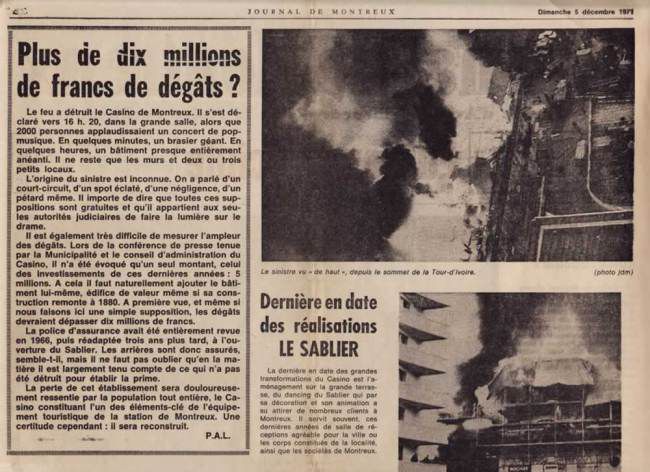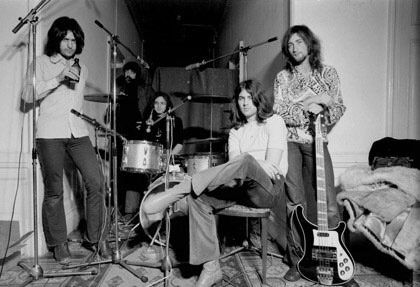
It can be said that March 25, both for Greece and for the bang, contains the term “revolution”. This is because to date, in 1972, one of the most defining hard rock albums, and by far the most important Deep Purple album, Machine Head was released. A truly revolutionary album.
Everything was to unfold in Montreux, one of the most beautiful cities in Switzerland, built on the shores of Lake Geneva (Leman). Winter 1971 and Deep Purple visiting the organizer of the annual jazz festival, which has been held since 1967 in the building of the local famous casino (since 1993 it has been held at the Montreux Music & Convention Center).
The English band 1.5 years ago will make three key moves that will give us an enchanting In Rock: they will replace singer Rod Evans with Ian Gillan, bassist Nick Simper with Roger Glover and hire in sound, console magician Martin Birch, who a few years later produced the golden age Iron Maiden, the first three and most important Rainbow albums and the unsurpassed Heaven And Hell Black Sabbath.
This line-up will already show their… teeth before In Rock by releasing a single called Black Night. With Child In Time it will make waves.

A little earlier, a 1969 experiment with an Albert Hall concert and a symphony orchestra had divided the band, and combined with Deep Purple’s low-flying “funky” Fireball (1971), Deep Purple were looking for a spark that would light the fuse again.
So, with the equipment loaded into the truck, the group will go to see the Frank Zappa concert, which probably closed the festival. The next day they will move into the same building to compose and record their new album.
The concert goes on until something bad happens. Two flares pierce the crowd and pierce the ceiling, which catches fire. The event is cut short and everyone leaves badly, with Zappa breaking his leg in a panic.
The image is surreal. One can imagine the building struggling to fall into the lake to save itself. This image gave birth to Smoke On The Water, a thousand-sung, thousand-losing, commented, and now a calling card of rock. What is the secret that has made the song so distinctive and enduring over time?
Blackmore explains: “Peter Townsend (The Who) told me, ‘Keep it simple and the audience will be with you.’ Smoke On The Water is instantly recognizable but unlike any other. I was somehow dismissively told: “It’s about 4 notes.” I tell them that Beethoven’s 5th symphony consists of four notes, and they fall silent.
Blackmore, though a quirky character, is perhaps, if not the greatest composer, then certainly one of them. It’s (was?) an incredible riffing machine. And some… the secrets of Smoke On The Water are his. As, of course, his heavy riff that emphasized and enhanced this particular song. But Blackmore is still doing something great here. Pay attention to 4:42. After three choruses, he plays the riff again and makes the track even more solid. Lord’s keyboard, which plays closer to the finale, is also characteristic: he holds a high note and plays from the lower pattern. As for Ian Pace, just admire his drumming.
However, in addition to the purely synthetic part, the conditions in which the work was written are also interesting, as is Machine Head as a whole.
So, going back to the fire incident, Purple after all these events were left without a musical roof to record an album. They found rough lodging at the Pavilion Hotel. But the intensity of the music during the early recording attempts quickly led to police banging on the main doors to force them open.
But the recording of the track was unstoppable – don’t forget that this is 1971. Technicians held the doors to keep cool instruments out until the song was over, outside the police were yelling “Police open!” and just like that, under these conditions, one of the most glorious pages of rock was written.

Eviction, of course, was not avoided and the group found … shelter in another hotel, albeit empty, because in the winter it was not active, but completely frozen. It was a huge Victorian building, the “Grand Hotel,” like… a haunted castle.
Under the circumstances, it was the best choice for the group. And everything started from scratch. Again the unloading of the machines, again the installation, again … again … The recording location was chosen … the junction of two T-shaped corridors. And everything began to be written there, within a few square meters.
Highway Star was the first to hit the rails. Earlier in the press conference, Glover was asked how he writes the track.
He started… scratching the bass to show demographers how and… that’s it. Their best song was written that same night. Bass chords, à la Bach, Lord’s keyboarding, incredible in a unique song.
Blackmore stated that at Highway Star he played 8 or 16 meters in a row, not knowing how it would end. Play almost all scales (blues, major, minor) and semi-classical rhythms with arpeggios. This huge guitarist influenced a number of neoclassical guitarists such as Yngwie Malmsteen, Timo Tolkki and Randy Rhodes.
Pictures of Home is perhaps the most… paranoid Deep Purple track in their entire discography. Pace starts with a drum roll in the intro, but in the finale he “responds” to every note received, and Glover gives us … a primitive, but very exciting bass solo.
On Space Truckin’, one of the features of the track is Lord’s harmonica, which connected the “beast” (as he called his instrument) to a Marshall amplifier rather than directly to the speakers. In the introduction, most people think it’s a guitar, not a harmonium.
Direct and… pure rock is present on Never Before, where Pace gives a solo concert on drums, while it is worth noting that Gillan’s vocals in the middle of the track are the product of a two-channel mix. Great track, as is Maybe I’m a Leo, and Lazy will have the misfortune of being on the same album as the holy monsters of Deep Purple. Despite this, Machine Head’s longest track is one of the band’s highlights. The composition that in 2013 made the great Joe Bonamassa, along with Jimmy Barnes, make an amazing cover.
What is Machine Head? Without a doubt…a miracle for the time and the way it came out. It was written all over the place (if they got it wrong on a track, they rewrote it!), but the band was at their peak and nothing stopped them from moving forward. About 25 months after the “eruption” of the “volcano”, Black Sabbath Deep Purple will release their heaviest album (at least at that time) and set a new direction for heavy sound.
Unfortunately, Purple failed to properly dispose of the musical and didactic richness of this album. They could not stand the pressure and their “ego”. Glover said: “Purple is two things. The superb musical knowledge of Blackmore, Lord, Pace, and the simplistic quality of Gillan’s handiwork and me.”
This magical lineup of Deep Purple lasted another collaborative album a year later (Who Do We Think We Are – perhaps including self-criticism?) before slowly… dissipating… across the five winds.
Gillan was replaced by David Coverdale in 1974, and the band released two superb albums, Burn and Stormbringer (with Glenn Hughes in last place).
Deep Purple’s first important period would end in 1975 with Come Taste The Band without Blackmore, who would be replaced with great success by the huge Tommy Bolin.
This dissolution will result in two more great bands: Blackmore’s Rainbow, which will grow the name of Ronnie James Dio, and Coverdale’s Whitesnake, as well as many other great collaborations with various artists.
Gillan, Blackmore, Glover, Lord and Pace reunite for the first time in 1984’s Perfect Strangers, but nothing has been the same ever since…
Source: Kathimerini
Ashley Bailey is a talented author and journalist known for her writing on trending topics. Currently working at 247 news reel, she brings readers fresh perspectives on current issues. With her well-researched and thought-provoking articles, she captures the zeitgeist and stays ahead of the latest trends. Ashley’s writing is a must-read for anyone interested in staying up-to-date with the latest developments.